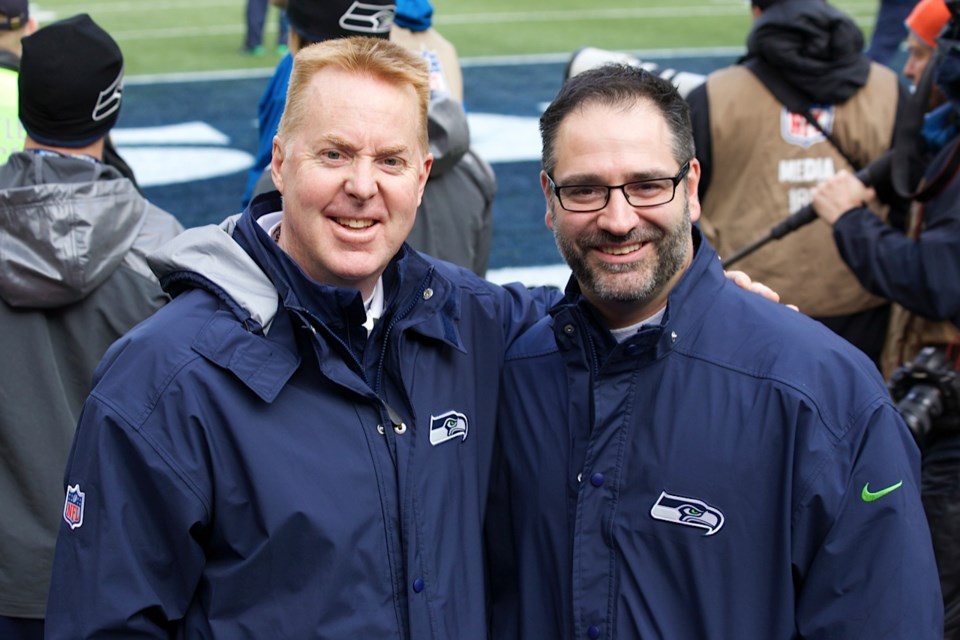When Burnaby chiropractor Gerry Ramogida saw a 30 second TV clip of legendary San Francisco 49ers quarterback Joe Montana getting a chiropractic adjustment on the sidelines of the 1989 Super Bowl – his destiny was sealed.
A former B.C. high school quarterback, Ramogida had already had his sights on a career in sports medicine.
Watching that video clip gave him the decisive nudge toward chiropractic.
“I was like, ‘Whoa, that’s cool,’” he told the NOW.
Cool as it is to watch, it’s even cooler to be there – and Ramogida should know.
On Sunday, flew to Phoenix for his third Super Bowl trip in 13 years as the Seattle Seahawks’ chiropractor.
“It just seems to get more and more crazy every year,” he said of America’s biggest sporting spectacle.
If this trip is anything like the last, the insanity will kick in as soon as the Seahawk’s chartered jet pulls into a hangar crammed with media at Phoenix Sky Harbor International Airport.
Last year in New York, Ramogida said the team’s four police-escorted buses shut down highways and freeways on the way to the hotel.
“It’s a great way to travel,” he said with a laugh.
Despite the hoopla, his work with the players will stay much the same this week.
His job is to stretch, rub and press muscles, tendons and joints until every limb on every player is moving and performing optimally.
It’s no small feat on bodies going into their 19th game this season.
“It’s not a forgiving sport,” Ramogida said. “Every game is a series of small car accidents with the impact that they take … From an injury standpoint, it’s almost across the board. You almost see everybody.”
Besides managing injuries, Ramogida also works to keep skill players – running backs, receivers, cornerbacks – fast and agile.
And during the big game Feb. 1, he’ll be working on players with existing injuries, like a D-lineman with degeneration in one knee that makes his quad and IT band knot up during play.
“When he’s not on the field, we’ll do work on the sideline to loosen things up,” Ramogida said.
How much difference does his work make?
“In that environment, it’s subjective to what the player feels,” he said. “If they’re feeling that it’s making a difference and that it’s influencing their performance, that’s probably the best feedback.”
Ramogida, who is director of chiropractic services at Burnaby’s Fortius Sport & Health, started working with the Seahawks 13 years ago.
He got the call because Seattle’s strength and conditioning coach at the time was friends with Dan Pfaff, an innovative University of Texas track coach Ramogida had worked with who recommended the Canadian chiro because of his skill in Active Release Technique (ART) – a emerging therapy professional athletes, including some Seahawks players, were seeking out.
The plan was to bring Ramogida on board for a couple years to train Seahawks staff in ART.
“It’s been 13 years and I’m still here,” Ramogida said.
It’s been an eventful 13 seasons, capped most recently by the Seahawks heart-stopping comeback overtime 28-22 win over the Green Bay Packers in the NFC championships last Sunday.
Ramogida admits he did some frantic calculations in his head after Green Bay’s fourth interception with just over five minutes left.
With the Seahawk’s down 19-7, he was figuring out how many possessions it would take to even things up and whether there was enough time.
The fans, he said, never wavered.
“The crowd was incredible,” he said. “There was a never a moment in that game where you felt the crowd had given up – the energy and just the volume. They never quit.”
The noise crescendoed when Luke Willson pulled in Russell Wilson’s two-point conversion pass to put the Hawks up by three with less than a minute and a half to go.
“It was incredible,” Ramogida said. “It was such a large wall of noise that you physically felt it. It makes you vibrate.”
Players and staff on the sideline erupted as well.
“Everyone was jumping, people were hugging,” Ramogida said. “I’m honestly wondering if my back got a little bit tweaked from that.”



